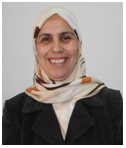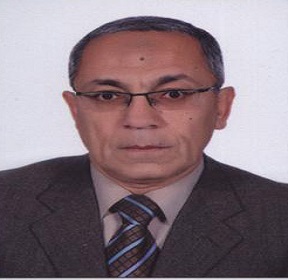Keynote Forum

Roseline Edide Archibong
United KingdomTitle: Food quality assessment of processed Telfairia occidentalis (Ikong Ubong) leaves
Abstract:
Title: Food quality assessment of processed Telfairia occidentalis (Ikong Ubong) leaves
Abstract:
The ready-to-eat (RTE) fruit and vegetable industry is a worldwide expanding sector. From 2000 to 2017, vegetables’ global production has increased by approximately 60%. Consumption of RTE vegetable salads has also increased within developing countries owing to a change in lifestyle patterns and growth of awareness regarding the positive relationship between human health and intake of RTE vegetables. Telfairia occidentalis otherwise called fluted pumpkin, fluted gourd or Ikong Ubong is a versatile tropical leafy vegetable in West Africa that belongs to the Cucurbitaceae family. Although edible plants such as T. occidentialis have many beneficial uses they have been associated with high levels of hygiene indicators such as Aerobic bacteria (aerobic colony count: ACC) and certain microbial pathogens due to poor post-harvest handling.
Biography:
Roseline is a passionate, experienced, and self-motivated Food scientist and Educationist with a successful track record in training, teaching, researching, developing and improving quality products for health-conscious companies. She has been successful in training and managing various projects and expertly delivering innovative and profitable solutions within the time frame and budget. Experienced in supervision, trainings, teaching, production processes, HACCP, quality control, sensory evaluation and research. A team player and an effective communicator verbally and in written form

Preeti Agarwal
IndiaTitle: Pulsed electric field treated milk improves the quality of curd
Abstract:
Pulsed electric field (PEF) is a potential pre-treatment technique to improve quality of milk by reducing its microbial load. However, since significant volumes of milk is processed by the dairy industry to dairy products, there is a need to evaluate the quality and acceptability of such products prepared using PEF treated milk. The present study aims at addressing this issue with respect to a popular fermented dairy product. The
Biography:
I am currently working in the area of non-thermal food preservation, fermented beverages, food packaging, and technology of millet-based beer. Advising several master scholars, participated in several national and international conferences and seminars, delivered lectures as Resource Person, Keynote speaker, in national, international conferences, and training programs, completed AUTOCAD 2D & 3D certification, received the Outstanding Scientist Award in the 7th International Scientist Awards on Engineering, Science, and Medicine, Women Scientist Award” by the Society of Agriculture Research and Social Development. Sponsorship to attend World Congress on Food Technology and Nutrition, 2022, Sponsorship and speaker at “International webinar on Nutrition and Healthcare” during November 24-25, 2022 in Paris, France, training of 21, 7 and 5 days. I have more than 125 publications including, 18 papers, 8 international CRC-Taylor and Francis edited books, 11 book chapters, about 30 popular articles, and 5 conference papers and 57 abstracts, 2 editorial opinions to her credit. Serving as an external examiner for various, Indian state agricultural universities. I am also serving as editor and reviewer of several journals national and international journals. I have reviewed more than 50 manuscripts.

Natisha Dukhi
South AfricanTitle: Factors associated with adolescent obesity in South Africa: empirical insights from a machine learning approach
Abstract:
Dr Natisha Dukhi is a Senior Research Specialist at the Human Sciences Research Council, South Africa. She has spent over a decade working as a Medical Scientist, specializing in Human Anatomy, Physiology, Pathophysiology and Nutrition at various universities in SA. Since 2009, she has been involved with community health and NGOs, and served as an online mentor for the Triune Uganda 2009 Global Project for Pharmacy and Social Science students from countries in Africa, America, Europe and Asia. In 2016, she graduated with a PhD in Public Health at the University of KwaZulu-Natal. She is an eclectic behavioral scientist, with various interdisciplinary research focuses. Her areas of expertise include Nutrition, Adolescent and Child Health, health promotion and non-communicable diseases, with special interest in mHealth, Artificial Intelligence, and gender-based violence. Her scientific experience and collaborations have led to various interdisciplinary publications, book chapters and conference proceedings. She is a reviewer for various national and international journals. She is a South African Young Academy of Science member, African Academy of Sciences (AAS) Affiliate, exco for Public Health Association of South Africa (PHASA) and OWSD SA National Chapter, Fellow and President of African ChangeMakers South Africa, Fellow of the Southern Africa and Africa Science Leadership Programmes, among others. In 2018, she was a BRICS Young Scientist awardee, and a recipient of the Gro Brundtland Award for outstanding work in the field of public health and development.

Title: EFFECT OF ZINC SUPPLEMENTATION ON BLOOD GLUCOSE LEVEL IN DIFFERENT AGE GROUPS OF DIABETES TYPE 2
Abstract:
Studies on humans have revealed the beneficial effects of zinc (Zn) supplementation in patients with type-2 diabetes. Aim: The present study was designed to investigate the effects of zinc supplementation on blood glucose level in type-2 diabetic patients and determine the interaction between age and zinc supplementation on type-2 diabetic patients. Methods: A randomized placebo-control trial conducted in Bashir Hospital of Sialkot, Allama Iqbal Memorial Hospital Sialkot and Civil Hospital of Daska, Sialkot. 144 diabetic patients were selected including an expected drop-out rate of 20%. All the participants were randomly divided into Group 1 (Treatment group with intervention given Zn tablets 20 mg/day) and Group 2 (control group with placebo effect). Each group was further divided into 2 age categories Category 1 (30-50 years of age) and Category 2 (51-70 Years of age). Demographic data, Anthropometric measurements, 24-h dietary recall, serum blood glucose analysis, HbA1C, and serum zinc levels were recorded at the beginning (0 day) and end of the study (60 days). Results: Final fasting serum glucose levels were significantly lowered in group 1 with (p < 0.05) as compared to group 2, but interestingly, results were significant (p < 0.05) in the older age group (51-70 years) as compared to their younger age counterparts (30-50 years) of group2. A similar trend was also found in the HbA1c, serum Zn levels and BMI of the participants. Conclusion: Results implied the possible phenomenon of better response to Zn supplementation among aged patients as compared to younger counterparts, which may suggest higher Zn demands with advanced age.
Biography:
Ms. Mahwish Aslam had worked as Senior Lecturer in The University of Lahore (UOL), and she also worked as a Consultant Dietitian in the department of UIDNS. She has published more than 8 papers in a well reputed journals and working on many projects.

Yumna Shehadeh
IsrealTitle: External Quality Assessment Scheme in Food Microbiology in Palestine
Abstract:
Microbiological testing of food is important for ensuring its quality and safety. Thus, it is a basic tools to assess the effectiveness of risk management programs for ensuring food safety and quality which necessitate the presence of Quality Assessment programs. Therefore, the Center for Quality in Medical Laboratories (CQML), Department of Medical Laboratory Sciences, Al Quds University, organized the external quality assessment schemes (EQA) in Water and Food Microbiology in support from the Food and Agriculture Organization (FAO), and Palestine Accreditation Unit (PALAC). The CQML is a Proficiency Testing (PT) provider in the Medical Laboratory field since 1995. The EQA scheme for food microbiology started in 2019. The EQA schemes is available to all food microbiology laboratories, providing schemes in water and drinks, meat and poultry, dairy products, fish and sea food, and salads. The participation is currently free of charge, but mandatory for accredited labs and voluntary for the others. Methods: There are 6 accredited food testing labs, and 2 labs belonging to food industry factories enrolled in the schemes. All the control materials used are prepared in house, offering freeze dried mixtures of organisms as simulated foods and water samples. The microorganisms used for spiking are American Type Culture Collection (ATCC) certified organisms. The control material are proven stable, homogeneous, prepared and tested by qualified microbiologists, interpretation of test results is presented in reports.
Biography:
Yumna Shehadeh is the Director, Center for Quality in Medical Laboratories she has published more than 25 papers in reputed journals and has been serving lecturer in Department of Medical Laboratory Sciences, Medical Laboratory Sciences, College of Health Professions, Al-Quds University, Abudis, Jerusalem -Palestine, Health Complex, level -1Yumna Shehadeh is the Director, Center for Quality in Medical Laboratories she has published more than 25 papers in reputed journals and has been serving lecturer in Department of Medical Laboratory Sciences, Medical Laboratory Sciences, College of Health Professions, Al-Quds University, Abudis, Jerusalem -Palestine, Health Complex, level -1

Inam Qureshi
UAETitle: Food Safety During and After the Era of COVID-19 Pandemic
Abstract:
The coronavirus disease 2019 (COVID-19) is a clinical syndrome caused by severe acute respiratory syndrome corona virus-2 (SARS-CoV-2). COVID-19 was declared a pandemic by the World Health Organization (WHO) on March 11, 2020 due to its rapid and extensive spread among many countries through its very contagious nature and its high mortality among the elderly and infirm. Recently, data on the survival of SARS-CoV-2 on contact surfaces has been reported, but there is none on the survival of COVID-19 on food surfaces and packages. The potential survival and transmission of SARS-CoV-2 on/via food and packages are discussed based on data available for other respiratory viruses such as SARS-CoV and MERS-CoV. However, studies are needed to explore its transmission via food and survival on food packaging materials. The implementation of food safety management systems such as Hazard Analysis and Critical Control Points (HACCP), and Good Manufacturing Practices (GMP) are important to reduce the risk of COVID-19 infection. Cleaning, sanitation, good hygienic practices, and active packaging are also needed from farm to fork.
Biography:
INAM has completed his MASTER DEGREE at the age of 25 years from URDU University. He is the SR FOOS SAFETY CONSULTANT. He has published more than 25 papers in reputed journals and has been serving as an editorial board member of repute.

Dr. Chritopher Larbie
GhanaTitle: Food Nutrition & Agriculture
Abstract:
Hepatotoxicity is an issue of global concern because of numerous liver-related deaths. In addition, conventional hepatoprotective and hepatocurative drugs are more expensive, uneasily accessible, and may have serious adverse effects. It is for these reasons that many people have resorted to traditional medicine. This study sought to evaluate the hepatoprotective effects of aqueous and hydroethanolic stem bark extracts of Tetrapleura tetraptera in paracetamol and carbon tetrachloride-induced hepatotoxicities in rats. Pulverized samples (500g each) were soaked in 1000 mL of boiled water and 50% hydroethanol respectively for 24 hours. Filtrates were extracted to obtain aqueous and hydroethanolic stem bark extracts, ASE, and HSE respectively. Extracts were evaluated for phytochemicals and free radical scavenging effects. Seventy-two male Wistar albino rats (120-180 g) were divided into eighteen groups with four in each group. Carbon tetrachloride (1.0 mL/kg b.wt; 1/1 v/v olive oil, intraperitoneal for 2 days) and Paracetamol (500 mg/kg b.wt p.o. daily for 7 days) were used to induce hepatotoxicity. The protective effects of extracts at 100 mg and 250 mg and silymarin (100 mg) were accessed. HSE had higher amounts of phytochemicals than ASE. The LD50 was above 5000 mg/kg b.wt. Hematological and biochemical analyses revealed HSE had a greater hepatoprotective effect against paracetamol and carbon tetrachloride compared to Silymarin. The liver antioxidant profile further confirmed ASE and HSE as hepatoprotective. These results indicate ASE and HSE of Tetrapleura tetraptera have hepatoprotective effects against paracetamol and carbon tetrachloride-induced hepatotoxicities in rats and could be developed as a potential liver protective agent.
Biography:
Dr. Christopher Larbie is a Senior Lecturer at the Department of Biochemistry and Biotechnology, Kwame Nkrumah University of Science and Technology (KNUST), and the Coordinator for Graduate Programmes in Biochemistry and Biotechnology at the Department. He holds a BSc and Ph.D. in Biochemistry focusing on pharmacological and toxicological evaluation of medicinal plants for managing drug-induced liver injury from the KNUST. His research interests further include the development of animal models for diabesity (coexistence of diabetes and obesity), site-specific cancers, and clinical evaluation of characterized medicinal products for human diseases. Experimental techniques employed include phytochemical screening for natural products, hematological and biochemical assessment, and histological and immunohistochemical assessment of pro- and anti-inflammatory cytokines.

Dr Goodluck Okereke
NigeriaTitle: Utilization of starches of white yam, trifoliate yam, sweet potato in wheat-moringa oleifera seed-based bread
Abstract:
Outrageous import bills on wheat, huge postharvest food losses, and increasing cases of malnutrition in Nigeria and other developing countries, are critical concerns craving brisk interventions of researchers in diverse fields, especially Food Science. In view of this, various composite bread (Samples B, C and D) were made from the blends of wheat flour, native starch of white yam/trifoliate yam/sweet potato and Moringa oleifera seed flour in the percentage ratio of 85:10:5 respectively. Nutritional and baking properties of these composite bread were investigated against that of ‘control bread’ (sample A- 100% wheat flour bread). Nutritionally, composite bread were significantly (p<0.05) higher than control bread; and also did not significantly (p<0.05) differ from it in terms of baking properties. Sample D (i.e. bread made from composite flour of 85% wheat flour: 10% native sweet potato starch: 5% Moringa oleifera seed flour) significantly (p<0.05) had highest values in protein (11.90%), calcium (116.30 mg/100g), iron (2.80 mg/100g), vitamin A (0.399 mg/100g), vitamin B1 (0.065 mg/100g), vitamin B2 (0.098 mg/100g), vitamin B3 (0.400 mg/100g), vitamin B6 (0.450 mg/100g), vitamin C (13.560 mg/100g), insignificantly (p<0.05) on crude fibre (1.40%); but had lowest values in carbohydrate (43.90%) and volume (325.03 cm3). Sample C (i.e. bread made from composite flour of 85% wheat flour: 10% native trifoliate yam starch: 5% Moringa oleifera seed flour) was significantly (p<0.05) highest in ash (2.42%), protein (10.80%), energy value (240.05 Kcal), calcium (112.23 mg/100g), iron (1.74 mg/100g), phosphorus (63.88 mg/100g), vitamin A (1.84 µg/g), vitamin B1 (0.036 mg/100g), vitamin B2 (0.065 mg/100g), vitamin B3 (0.170 mg/100g), vitamin B6 (0.210 mg/100g), vitamin C (11.380 mg/100g). Sample B (i.e. bread made from composite flour of 85% wheat flour: 10% native white yam starch: 5% Moringa oleifera seed flour) recorded best values in carbohydrate (51.98%), energy content (267.50 Kcal) and shelf-stability potential (i.e. lowest moisture content of 31.47%) but lowest values in magnesium (56.30%) and general acceptability (5.68). These results are a pointer of the potentials of these underutilized food crops in addressing food insecurity.
Biography:
Okereke Goodluck Obioma is a phenomenal food expert that has experience, spanning for more than a decade in both food industry and academia. He has a Ph.D in Food Science and Technology (funded by World Bank through Centre for Food Technology and Research) from Benue State University, Makurdi, Nigeria, which is his affiliation as an eminent researcher and lecturer. He obtained a Master of Science (M.Sc) in Food Processing and Preservation from Michael Okpara University of Agriculture, Umudike, Nigeria; and a Bachelor of Technology (B.Tech) in Food Science and Technology at Federal University of Technology, Owerri, Nigeria. Besides, he is a dependable team player with Coca-Cola Hellenic Bottling Company, Nigeria and consults with many food firms as well. He has authored many influential local and international publications that form a research base to scientists globally. Okereke Goodluck Obioma serves as a peer reviewer and editorial board member to many top-notch international journals; and has made many remarkable presentations at several first-class events. His research interests are in postharvest food losses, food security, water treatment, starch, beverage and bakery manufacture.

Dr Mary Stella wabwoba x
Food and Nutrition security status of Households in Kenya Masinde Muliro University of Science and TechnologyKenyaTitle: Food Nutrition & Agriculture
Abstract:
Introduction: Food and nutrition security for every household is public concern throughout the globe. Food is a basic necessity of life as it dictates the health status of individuals. Statement of the Problem : Documented evidence shows insufficient food stocks among households in Kenya. Available literature indicates that Bungoma County is food insecure with a poverty index of 52.9%. The objective of this study was to determine the food security and Nutrition status of households in Bungoma County. Methodology & Theoretical Orientation: A cross-sectional survey design was used in the study and a cluster sample size of 384 households was selected. Tools used for data collection were questionnaires, interview guides, focus group discussions and observation checklists. The nutrition status of pre-school children was determined by measuring the Mid Upper Arm Circumference (MUAC) and Body Mass Index (BMI) tools were used to determine nutritional status for pre-school children and adults respectively.
Biography:
Marystella Wabwoba is a Professional public officer well versed with extension approaches, distinguished by commended performance and proven results. Skilled in sustainable Development and community development, Disaster management with wide experience on research on food security in Kenya. Extensive background in training of trainers (TOT), including experience in community mobilization, training on Entrepreneurship, training youths in Vocational centres, Trainer of stakeholders and communities on Good Agricultural Practice and investment options that affect food security. Demonstrated success in assigned duties- developing teambuilding programs, and writing departmental reports, participating in developing departmental strategic plans and policies in compliance with the Kenya constitution, 2010.

Baher Effat
EgyptTitle: Food Nutrition & Agriculture
Abstract:
Biography: Baher Effat is a Research Professor of Food and Dairy Microbiology, National Research Centre, Egypt. Over 36 years of experience in Food and Dairy Bacteriology, he shared and supervised over than 6 Master and Ph.D Thesis in Food and Dairy sciences and more than 61 scientific publications in food and dairy microbiology, functional dairy products , probiotics and propionic acid bacteria and pathogenic bacteria and in Food and Dairy Products. He has shared in national and international programs and projects. He joined many international conferences and workshop, in addition to scientific activities. In addition he awarded for CAS-TWAS Visiting Scholar Fellowship From 03 Aug., 2006 to 31 October 2006.Training of young researchers and lecturers on many science-related subjects; including courses for: Microbiological Analysis of Food, Control of Bacteria, Contamination during Food Process and Isolation and Identification of Microorganisms. He is a member of the Editorial Board of several international journals. He also served as a member of the Organizing Committee in International Congresses.

Mr Ovanes Chakoyan
BulgariaTitle: Food Nutrition & Agriculture
Abstract:
Title: NEW OFF-LINE SPE-GC-MS/MS METHOD FOR DETERMINATION OF MOSH/MOAH IN ANIMAL FEED, FOODS, INFANT FORMULA AND VEGETABLE OILS
Abstract:
MOH (mineral oil hydrocarbons) which consist of mineral oil saturated
hydrocarbons(MOSH) and mineral oil aromatic hydrocarbons(MOAH) are present in various
products such as vegetable oils, animal feed, foods and infant formula. Contamination of foods with
mineral oil hydrocarbons, particularly mineral oil aromatic hydrocarbons(MOAH),exhibiting
carcinogenic, mutagenic and hormone-disruptive effects. Identifying toxic substances among the many
thousands comprising mineral oils in food samples is a difficult analytical challenge. A new method
based on an offline-solid phase extraction approach coupled with gas chromatography-triple
quadrupole(GC-MS/MS) was developed for determination of MOSH/MOAH in various products such
as vegetable oils, animal feed, foods and infant formula. A glass SPE cartridge loaded with 7 g of
activated silica gel impregnated with 10 % silver nitrate for removal of olefins and lipids. The
MOSH/MOAH fractions in the oil samples were eluated with hexane and hexane: dichloromethane
:toluene(75:20:5), respectively. Each eluate was concentrated to 50 µl in toluene and injected on
splitless mode into GC-MS/MS. Accuracy of the method was estimated as measurement of recovery of
spiked oil samples at 2.0, 15.0 and 30.0 mg kg -1 , and recoveries varied from 85 to 105 %. The method
was applied to the different types of samples (sunflower meal, chocolate ships, santa milk chocolate,
biscuits, infant milk, cornflakes, refined sunflower oil, crude sunflower oil), detecting MOSH up to 56
mg/kg and MOAH up to 5 mg/kg. The limit of quantification(LOQ) of proposed method was estimated
at 0.5 mg/kg and 0.3 mg/kg for MOSH and MOAH ,respectively.
Biography:
Ovanes Chakoyan studied Organic Synthesis at the University of Chemical Technology and Metallurgy of Sofia, Bulgaria as Bachelor in 2008. He is chief researcher/chromatography expert in Fidelitas Lab, Bulgaria.He received his M.D. of Organic Chemistry from University of Shumen in 2022. He has over 10 years practical skills in areas of gas chromatography and liquid chromatography, including developing new analytical methods and sample preparation in environment, soil, water, air pollution and food matrices.

Farhana Nosheen
PakistanTitle: Impact of Lipid-based Nutrient Supplementation for Pregnant and Lactating Women Provided by World Food Program
Abstract:
Statement of the Problem: A major global issue is inadequate nutrition among expectant and lactating mothers. Micronutrient deficiencies (MNDs) have a wide range of effects on fetus, such as stunted growth, intellectual impairments, development difficulties, and elevated morbidity and mortality risks. Lipid-Based Nutrient Supplements (LNS) have been suggested as a viable remedy to improve the nutritional status of expecting and lactating mothers to address MNDs. In Pakistan, the WHO started the LNS-PLW initiative under the World Food Program and with the Government of Pakistan incorporated it into the basic healthcare system. The purpose of this study is to evaluate the effectiveness of LNS in pregnant and lactating women and to determine the extent of micronutrient deficiency in pregnant and lactating women of the 2nd and 3rd trimesters. Methodology & Theoretical Orientation: An Assessment, biochemical, and dietary study were utilized during impact assessment report. The sample of 160 women were taken, and anthropometric measures, CBC, dietary histories, and demographic information were obtained using the nutritional assessment form Findings: The results showed that the majority of women were between the ages of 26 and 30, had low socioeconomic status, and were illiterate. A paired sample t-test revealed a significant difference in hematocrit HCT in the control group. In the interventional group receiving LNS, significant differences were found in WBC (p-value 0.036), RBC (p-value 0.015), HGB (p-value ≤ 0.000), and HCT (p-value 0.017). Additionally, there was a significant difference in HGB (p-value 0.086) levels between the control and interventional groups, indicating improved nutritional status among those receiving LNS. Pearson chi-square testing showed a significant difference (p ≤ 0.05) in the physical condition of pregnant and lactating women in the control group, particularly in skin, nails, and hair conditions after three months. The significant differences were noted in the MUAC of pregnant women (p-value 0.024) and lactating women (p-value ≤ 0.000) in the interventional group receiving LNS supplements. Thus, it was concluded that there is micronutrient deficiency among lactating and pregnant women from low socioeconomic status. Physical exams or psychological issues were not significantly impacted by LNS; however hematological parameters, and MUAC, depicted significant changes. Notably, LNS supplements have shown promise in raising HGB levels, which makes them a recommendation for anemic women or other nutritional deficiencies during pregnancy and lactation. A country-level action is required to improve food safety regulations to promote the fortification of food and to develop food-based dietary guidelines.
Biography:
My professional and research focus is food and Nutrition of community significance using conventional and community based integrated approach. Major area of interest is women and child health & nutrition, extension agricultural education, skill development and entrepreneurship in food and agriculture sciences. I am involved in various graduate disciplines like food & Nutrition, Climate Change, community development, rural development and Public Health which allows me to inter-link various facets of the food nutrition and agriculture. Presently, I am working Associate Professor and chairperson of Home economics department, GC University Faisalabad, Pakistan. I have been win competitive grants from national and international funding organizations as PI/ Co-PI and mentored >40 M.Phil. and PhDs as supervisor. The GC University Faisalabad awarded me Research Productivity Awards consecutively for the 5 years (2018-2023). I have published ~50 research papers in ISI indexed journals having IF, one text book titled Women in Agriculture in Pakistan.

